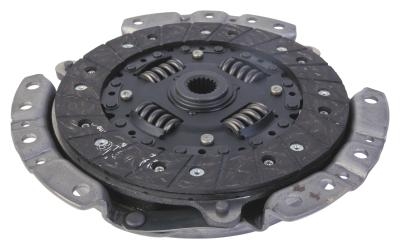
The clutch is a mechanism which allows the transmission to disengage from the engine. Clutch disengagement is necessary to change gears, as well as to coast in neutral. When beginning acceleration from a stop, the clutch pedal must be released slowly so the clutch mechanism engages smoothly. Due to this slipping process, as well as the constant actuation of the clutch mechanism, clutches are liable to go bad over time. Luckily, diagnosing a bad clutch requires no mechanical work on the vehicle.
Depress the clutch pedal and pay special attention to the feel of the pedal's resistance. If the clutch pedal has suddenly become easier to depress, this is a sign of worn clutch plates. However, inconsistent clutch pedal feel can also indicate a malfunctioning clutch cylinder system, which contains the hydraulic clutch fluid. Before you have your clutch replaced due to inconsistent pedal feel, have the clutch cylinder system inspected by a professional. It may require only a relatively simple fluid bleeding and replacement procedure, which is much cheaper than a clutch replacement.
Listen closely for any noises coming from the clutch area when the clutch pedal is depressed. It helps to have a passenger stand beside the vehicle with the engine hood open, as the clutch noise will be more audible from the outside of the vehicle. A whining or screeching noise generally indicates that the clutch mechanism is not fully disengaging. This is often a sign of a worn throw-out bearing or pilot bearing, connected to the clutch engagement mechanism.
Accelerate your vehicle from a stop, slipping the clutch as you do under normal vehicle operation. If the clutch slips excessively or is hesitant in grabbing, this is a sign of worn clutch plates. Worn clutch plates may also grab inconsistently, creating a vibration or chatter upon acceleration.
Accelerate your vehicle from a stop and monitor the tachometer, which displays the engine rpm value. If the rpm value climbs excessively when you slip the clutch, this is a sign that the clutch plates are not grabbing properly. As the clutch plates wear down further over time, the friction generated by the clutch mechanism will diminish as well. This leads to further clutch wear, up to the point that the clutch may barely engage at all.
Open the engine hood and note the presence of any burnt smells. When the clutch mechanism slips, the friction plates are ground down slightly. Excessive clutch slippage will generate a smell similar to burnt plastic due to the heated friction plates. In more extreme cases, this smell may be present in the vehicle cabin, especially when driving in stop-and-go traffic.